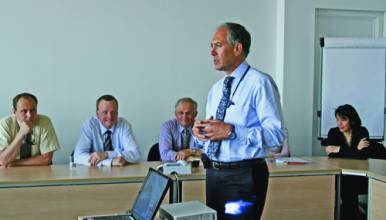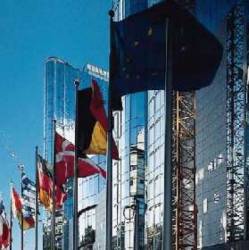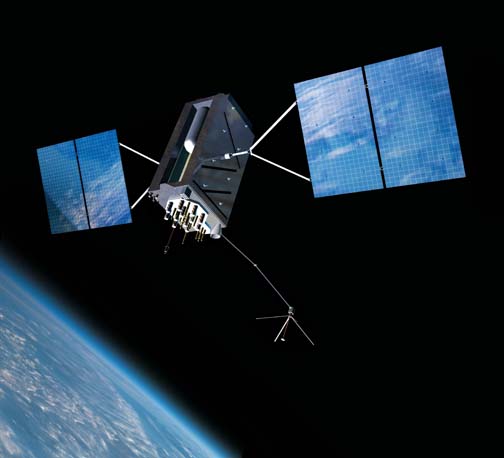Sometimes things don’t go as planned.
That certainly is the situation facing the European GNSS Supervisory Authority (GSA) today as the new lead agency for Galileo affairs.
A meltdown of the public private partnership (PPP) that was supposed to build and operate Europe’s GNSS has thrust an unexpected — and unscripted — role into the hands of the GSA almost at the very moment that the new organization first stepped onto the public stage.
As originally envisioned, the GSA — a European community agency operating under the aegis of the European Commission (EC) — had only to “conclude a concession contract with whichever consortium is selected on completion of the development phase of Galileo.”
Not “negotiate” a contract — that was the task of GSA’s predecessor, the Galileo Joint Undertaking (GJU) — but merely sign off on the deal. And then monitor the contract’s implementation on behalf of its public sponsors while taking up a full suite of other tasks.
Instead, on May 11, the GSA Administrative Board delivered its opinion that progress in negotiations with the consortium of eight companies seeking the 20-year concession contract was not making “relevant progress at the level” needed to ensure a timely completion of the Galileo project.
That conclusion by the GSA board, and a set of alternative courses of action, will now go to the European Union (EU) Transport Ministers Council in early June.
At the center of the storm are the GSA and its executive director, Pedro Pedreira, who took up his responsibilities in July 2005. Before his GSA appointment, Pedreira was serving as director of business development at Portugal Telecom, having spent more than 20 years in the satellite communications field.
Still unfamiliar to many in the GNSS community, the GSA has a €420 million budget for 2007, including €40 million in this year’s R&D allocation from the EC’s 7th Framework Program. An administrative board with representatives from the EU’s 25 member states oversees the authority. Unlike many European Community institutions, however, the board only requires two-thirds majorities for its decisions, which should enable it to act quickly and powerfully.
Although he has been at the GSA nearly two years, it was only upon the “liquidation” of the GJU in January that Pedreira and his organization became truly visible. During the interim, his focus was on building a staff with “critical mass” — now numbering about 50 — and preparing for the authority’s role as the lead agent for supervising implementation of Galileo and monitoring compliance of a Galileo Operating Company (GOC) with the concession contract.
In a series of exclusive conversations with Pedreira and key GSA staff members in March and May, Inside GNSS explored the agency’s mission and the implications of a potentially strategic change of direction for the Galileo program and the authority’s role.
European sources close to the concession negotiations have told Inside GNSS that the leading alternate approach to a PPP is an outright public takeover of the project now and issuance of a new tender for a private operator once most or all of the Galileo space and ground infrastructure is built.
Pedreira would not discuss the specifics of any of the proposed alternatives before they are presented to the transport ministers in June. However, he acknowledged that “the original mandate [to the GSA] was based on a certain model – PPP.” Depending on the decision reached by the transport ministers, “The Council may look at the governance of the program and adjust the mandate of the GSA.”
More, and Then Less
As laid out in a July 12, 2004, EU Council regulation establishing the GSA, the first order of business for the authority was to “conclude a concession contract with whichever consortium is selected on completion of the development phase of Galileo and take steps to ensure compliance by that consortium with the obligations — in particular the public service obligations — arising from the concession contract.”
Because at the time it went out of business the GJU had only managed to thrash out a “head of terms” agreement — essentially, the chapter headings and outline of points for an eventual contract — it initially appeared that GSA would be saddled with a lengthy negotiation with the private consortium. Instead, by the time of the Munich Satellite Navigation Summit in early March, Pedreira and EC Director-General for Transport and Energy Matthias Ruete were decrying the failure of the consortium to incorporate, appoint a CEO, and finish talks on the concession contract.
At a March 22 meeting, the transport ministers gave the consortium until May 10 to meet a series of milestones, leaving it to the EC, “assisted by GSA and ESA [the European Space Agency], to assess progress in the concession negotiations and to submit alternative scenarios, also assessed for costs, risk, and affordability,” in time for their June council meeting.
“The council in March noted its previous decision to implement the project with PPP,” says Pedreira. “But we could have a different geometry of partnership [with the private sector]. It could have a different shape.”
So, what happens to GSA if the transport council (and probably the Ministers Council — heads of state of the 25 EU members) drops or delays implementation of the PPP concept and goes for an public sector–only plan?
“It’s too soon to see how to adjust forms of the current organization,” says Pedreira. “The concession has taken a considerable amount of our resources. We have been giving a priority to the concession [since GSA was established].”
Indeed, supporting the GSA concession effort, headed by Carlo des Dorides who had served as chief negotiator with the GJU, was at the top of several other GSA administrators’ agendas.
In a March interview, Gian Gherado Calini, head of market development, told Inside GNSS that his group had two main tasks: first, the concession and working with des Dorides to identify size and growth of those markets supported by services operated by the concession. Second came downstream markets and creating conditions for them to succeed.
At that time, Hermann Ebner, head of the largest GSA unit, the Technical Department, put support for the concession process at the top of his list as well. A GSA technical task force had completed an assessment of design risks, and the department handled design revisions proposed by the consortium and kept a running tab on the changing cost figures associated with the program.
Even the security section had a role through the PACIFIC project to size the potential markets for the publicly regulated service (PRS), an encrypted signal designed for public safety, law enforcement, and possibly military applications.
Still Plenty to Do
Although the concession headed the list of GSA responsibilities, it is far from the only task given the agency by the 2004 regulation.
“Many aspects of GSA role are independent of the procurement model,” Pedreira says, ticking off some of the others that are top of mind: Galileo security, frequency coordination, management of R&D programs, and integration of the European Geostationary Navigation Overlay Service (EGNOS, essentially a satellite-based augmentation system) into the Galileo infrastructure and operations.
In the matter of market development, for instance, Pedreira points out, “The business plan of the concession internalized only a fraction of the public activity [in application markets].” The Open Service, from which an overwhelming portion of Galileo market revenues will come, was not part of the concession’s mandate. That represents, in Calini’s words, “a gold mine” of potential new services and products.
Getting Technical. Meanwhile, the EC 7th Framework Program has allocated a total of €350 million over the next seven years for R&D projects under the GSA’s control, plus any still-uncompleted FP6 projects taken over from the GJU. The first calls for tenders on FP7 projects this year will target applications, receiver development, and Galileo implementation, says Ebner.
Another large item on Ebner’s agenda, regardless of GSA’s partner in moving Galileo forward, is system definition and development. On May 11, the agency published announcements for a system definition and performance head, a space segment implementation officer, and a ground mission segment implementation officer.
Other major tasks for the GSA Technical Department include managing the Galileo signal Interface Control Documents (ICDs) and frequency coordination. At its March 21 meeting, the GSA Administrative Board issued notice of an intention to proceed with implementing the multiplexed BOC waveform that will serve as the basis not only for Galileo Open Service signals but the new GPS civil signal at the L1 frequency (L1C).
Unlike the GJU, GSA can sign contracts and handle international agreements previously overseen by other EC departments. It has taken over from the GJU the responsibility for keeping track of projects by the People’s Republic of China, Israel, and other co-investors in Galileo.
Keeping Galileo Safe. Nearly untouched by the success or failure of the concession is the GSA’s role regarding security for the Galileo system — including space, ground, and user segments. “Galileo is the first EU space program for which security was needed,” says Olivier Crop, the agency’s PRS officer.
The GSA has created a System, Safety, and Security Committee (3SC), which will be a key player in EU decisions on Galileo. The authority also will be responsible for establishing a Galileo Security Center charged with helping protect the system’s critical infrastructure, controlled signals, and PRS-capable user equipment.
EC policy on PRS, which was only approved for inclusion in Galileo in 2004, lets every member nation decide whether they want to allow use of PRS within their own “sovereignty domain.” Each country controls access to its own receivers, but operations in other countries or throughout the EU generally requires approval of the European Council.
EGNOS. The 2004 council regulation also entrusted the GSA with “managing the agreement with the economic operator charged with operating EGNOS and of presenting a framework on the future policy options concerning EGNOS,” which is largely complete and in provisional operation.
In 2004, with the incorporation of EGNOS into the concession, Pedreira says, came the recognition “that the consortium could not tackle [operating EGNOS] as soon as hoped. There was a need to go for an open tender on EGNOS economic operation.”
EGNOS, in fact, was a subject of discussion at the GSA board’s May 11 meeting. “There are many aspects to settle,” says Pedreira — issues involving ESA and the aviation organizations that are co-owners of EGNOS with the EU. “We will need to transfer assets to GSA to proceed with an open tender” for a service provider to implement early operation of EGNOS.
“At the working level, GSA has very good, very intense relations with ESA, especially on EGNOS and IOV,” he adds.
The GSA is also charged with responsibilities during the in-orbit validation (IOV) phase of Galileo’s development, although ESA is in charge of the technical side of things. “It would be surprising if the council went for a solution without taking note of the progress on the IOV phase and making best use of the assets and investment made to date.”
Perhaps most significantly, under the 2004 council regulation the GSA owns the tangible and intangible assets created during the development and implementation phases of the program. In other words, the agency is the legal guardian of the public interest in Galileo.
Overhanging that role, of course, is what the GSA’s political masters — initially, the transport ministers and, ultimately, the member states — decide to do about Galileo as a whole.






